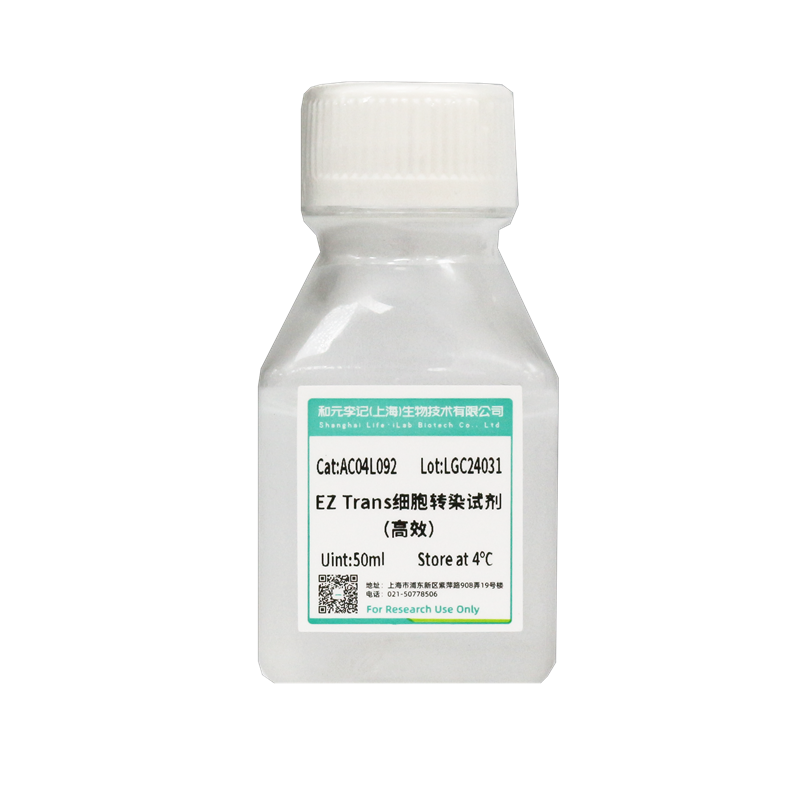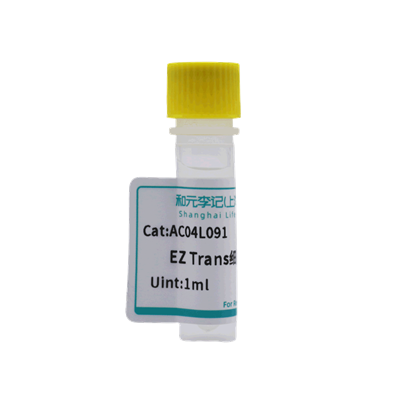Product Description
EZ Trans Cell Transfection Reagent (Efficient), as a new generation of transfection reagents, its transfection principle is that positively charged cationic polymers and negatively charged phosphate groups in nucleic acids form a positively charged complex, which interacts with negatively charged proteoglycans on the cell surface and enters the cell through endocytosis.
This product has been optimized by Li Ji Biotechnology and has the characteristics of high transfection efficiency, low cytotoxicity, simple operation, good repeatability, and wide applicability.
A high scoring article is displayed in the product literature, and more information can be found on the official website - Resource Support - Literature Research.
More cases can be found on the official website - Resource Support - Case List Appreciation and Query.
Product advantages
1. The raw material of this product is cationic polymer, which is very similar to cationic liposomes and can basically completely replace Li * *;
2. The dosage and usage are the same as Li * *, and the price of the large packaging is only 1/40 of theirs, bringing you the ultimate cost-effectiveness.
3. Case list and literature can be found on the official website - Resource Support!
Product components
Product Name | Specifications |
EZ Trans Cell Transfection Reagent (Efficient) | 1 mL |
EZ Trans Cell Transfection Reagent (Efficient) | 50 mL |
Transportation and Preservation
Blue ice transportation. Store at 4 ℃, valid for 12 months. [Note]: Do not freeze!

This product is limited to scientific experimental research and cannot be used in clinical diagnosis, treatment, or other fields.
Fill in the product batch number for querying
Fill in the product batch number for querying
[{"text1":"Li Ji has three transfection reagents, what is the difference between these three? How does it compare to Li * *?","text2":"Our company conducted self testing and collected customer feedback data, and obtained similar conclusions: in terms of efficiency, EZ Trans Plus>Li * * 2000 \u2248 EZ Trans (high efficiency)>Li * * 3000>EZ Trans (low toxicity). Toxicity: EZ Trans (low toxicity) \u2248 Li * * 3000 \uff1c EZ Trans Plus \uff1c EZ Trans (high efficiency) \u2248 Li * * 2000. \""},{"text1":"Do antibiotics have an absolute impact on transfection efficiency in the cells we transmit?","text2":"It is possible to avoid adding antibiotics as much as possible. In theory, antibiotics cannot enter cells, but under the action of transfection reagents, the permeability of cells increases, and antibiotics may enter cells, which may affect the completion of experimental results."},{"text1":"The protocol mentions diluting plasmids and transfection reagents with Opti MEM. Can't we dilute it with 1640? Why do plasmids and transfection reagents need to be diluted before mixing? Can't the transfection reagent be directly added to the plasmid solution and mixed, and then diluted with culture medium?","text2":"EZ Trans cell transfection solution belongs to cationic transfection reagents, which require certain conditions to form complexes with DNA. At appropriate concentrations, it is beneficial for cations to wrap DNA and form well shaped complexes into cells. If the two are directly mixed, they are prone to quickly form polymers with diverse aggregation phases, which may expose DNA to the surface and make it difficult to enter cells, thereby reducing transfection efficiency. So the mixing order of EZ Trans and DNA is also important. Most cells are cultured using fetal bovine serum, which has complex components and no one can explain its composition and content. The composition of the cell transfection solution is relatively clear, but it cannot be determined whether it will bind with unknown components of fetal bovine serum. In fact, this phenomenon can cause adverse effects in most transfection reagents, so it is necessary to avoid the influence of serum during the formation of EZ Trans-DNA complexes."},{"text1":"The protocol mentions that \"testing transfection efficiency within 24-48 hours\" refers to 24-48 hours after removing the culture medium containing the complex and replacing it with serum containing culture medium, or 24-48 hours after adding the complex and transfecting?","text2":"All time starts from the contact between EZ Trans-DNA complex and cells."},{"text1":"I just asked about directly transfecting mice into the body. Is your existing protocol an in vitro experimental method?","text2":"The most commonly directly transfected viruses in the body are adenoviruses, lentiviruses, and adeno-associated viruses. We have not heard of any reports of transfection reagents being used directly in vivo. The current approach is for cells to be cultured in vitro, transfected and screened, and then injected into the body."},{"text1":"The protocol mentions that EZ Transs are all transfected with DNA, but now I want to transfect siRNA. Can this be achieved?","text2":"RNA transfection is possible, but due to different cell toxicity, the efficiency and research results of RNA transfection need to be explored (currently, half of the customers have reported that RNA transfection is possible, but the general customer feedback is not good). In this regard, like liposome transfection, RNA transfection is generally focused on studying its function. The cytotoxicity of transfection reagents may interfere with the determination of the function of small RNAs, and teachers need to conduct preliminary experiments"},{"text1":"The protocol mentioned that it is optimem medium. Can we use your EZ Trans for transfection in CD2 medium?","text2":"This culture medium can be used as long as it does not affect cell growth. However, during the transfection configuration process, serum is not added. If optimem cannot be used for preparation and transfection, and only CD2 can be used, then he will use CD2 for preparation and transfection, and it is best to conduct a preliminary experiment."},{"text1":"Low transfection efficiency - no high efficiency DNA transfection reagent complex generated","text2":"When preparing DNA transfection reagent complexes, please do not use products containing serum. In most cases, efficient DNA transfection reagent complexes can be obtained by using serum-free DMEM culture media. We suggest using serum containing mediators for transfection, as the single host complex must form in serum-free medium. Note: It is best to avoid Opti MEN culture medium even if its serum content is low"},{"text1":"Low transfection efficiency - there are inhibitors that inhibit the formation of DNA transfection reagent complexes during the process of generating DNA transfection reagent complexes","text2":"The culture medium without serum is the key to the formation of efficient DNA transfection reagent complexes. During the process of generating complexes, avoid using chemicals such as high concentrations of phosphate, chondroitin sulfate, hyaluronic acid, dextran sulfate, or other sulfated proteoglycans"},{"text1":"Low transfection efficiency - the transfection reagent complex contains serum","text2":"When preparing the DNA grabbing reagent complex, please use serum-free medium or Opti MEM culture. In most cases, using serum-free DMEM culture medium can yield DNA transfection reagent complexes that improve efficiency."},{"text1":"Low transfection efficiency, high cytotoxicity - cell density not optimized","text2":"During DNA transfection and co transfection with DNA siRNA, cell density is controlled between 60% -70%; During siRNA transfection, cell density is controlled at around 50%"},{"text1":"How to determine the transfection efficiency of the experiment?","text2":"It is recommended to set a positive control, such as green fluorescent protein (GFP), during each transfection."},{"text1":"Low transfection efficiency - placing transfected complexes at room temperature for a long time","text2":"The EZ Trans cell transfection reagent should be stored at 4 \u2103. The optimal placement reagent and temperature for transfection complexes are 10-20 minutes at room temperature. Prolonged placement can significantly reduce transfection efficiency. Please make sure to control the placement time within 20 minutes."},{"text1":"Low transfection efficiency - high speed centrifugal transfection of complexes","text2":"When forming transfection complexes, standard operating procedures recommend vortex mixing transfection reagents and DNA or siRNA within a few seconds to produce efficient transfection complexes. If you want to centrifuge the composite adhered to the pipe wall, be sure to use extremely low speed centrifugation, such as 80g centrifugation for 5 seconds."},{"text1":"High cytotoxicity - excessive dosage of DNA","text2":"Suggest drawing a dose-response curve to determine the optimal DNA dosage."},{"text1":"High cytotoxicity - excessive amount of transfection reagent used","text2":"Suggest drawing a dose-response curve to determine the optimal amount of transfection reagents."},{"text1":"High cytotoxicity - poor cell state during transfection","text2":"The transfection efficiency of EZ Trans cell transfection reagents is not affected by the serum in the culture medium. Therefore, it is recommended to use a complete culture medium containing 10% fetal bovine serum and antibiotics during the transfection process to improve the cell state."},{"text1":"High cytotoxicity - antibiotics added too early during stable transfection","text2":"Please add selective antibiotics after 48 hours of transfection."}]







 Back
Back


























